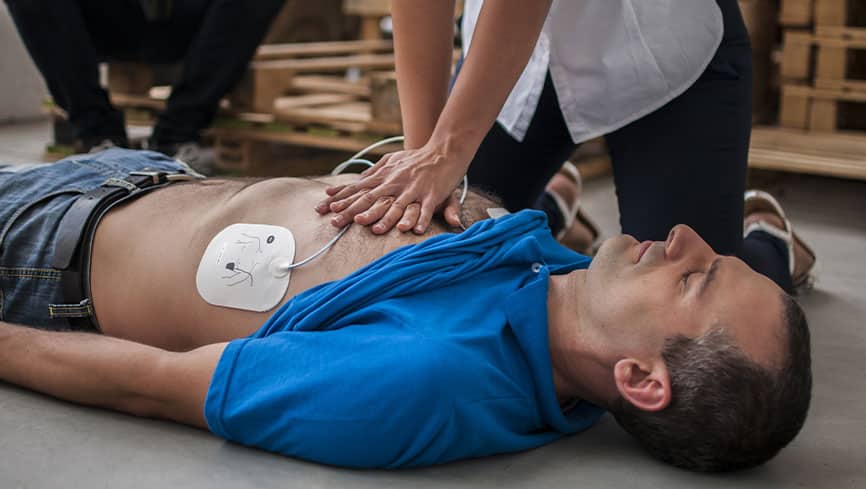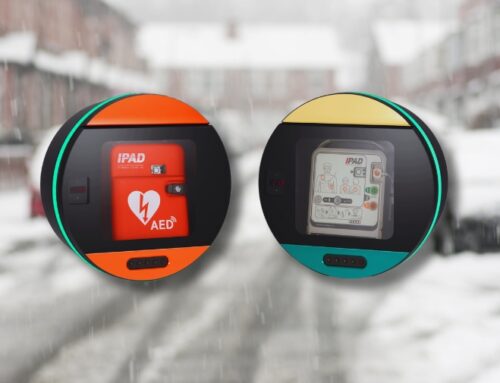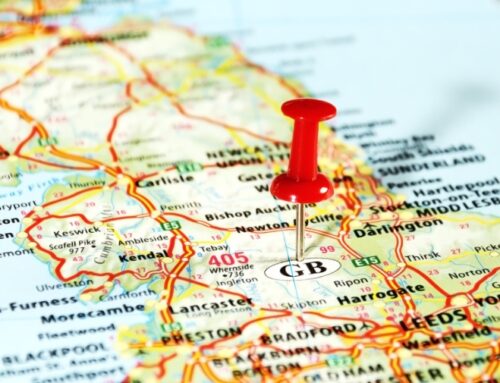[vc_row][vc_column][vc_column_text]How do you use a defibrillator and what happens when you do? Read below to find out.
Ask most people ‘what is a defibrillator?’ and they’ll tell you it’s a device used by paramedics who place two large hand paddles on a person’s chest in order to deliver a loud shock that restarts a flatlined heart.
Barring the shock itself, none of that is actually true.
In reality, automated external defibrillators (AEDs) have come a long way since the devices made famous in films and TV shows.
Today’s AEDs are compact devices that will first check a patient to see if they have a ‘shockable’ heart rhythm (very different to a heart that’s stopped beating altogether). If they do, the AED will deliver a shock either automatically or at the press of a button on the unit – but not via paddles, it’s delivered through electrodes affixed to the casualty’s upper torso via sticky smart pads.
Crucially, modern defibrillators are incredibly easy to use and offer prompts to tell you what to do. Members of the public can use a defibrillator after just a simple familiarisation session, which we at WEL Medical offer as part of our service.
Of course, the obvious next question to ask is…[/vc_column_text][vc_empty_space][vc_column_text]
When would you need to use a defibrillator?
[/vc_column_text][vc_empty_space height=”16px”][vc_single_image image=”2287″ img_size=”full”][vc_column_text]A defibrillator is used to treat a cardiac arrest – like the recent high-profile on-pitch collapse of footballer Christian Eriksen.
You should use one when someone falls unconscious with no visible signs of life. That means they’re unresponsive and have stopped breathing normally. Essentially, whenever you need to use CPR, you should use a defibrillator quickly as possible afterwards. You cannot make things worse by using a defibrillator – so you absolutely should not delay if you find yourself in this situation.
Every minute that goes by without treatment lowers a person’s chance of survival from a cardiac arrest by around 10%. The average UK ambulance response time is seven to eight minutes, so the stark reality is that delivering CPR and defibrillation before an ambulance arrives is likely to be the difference between that patient living or passing away.
How to use a defibrillator and what happens next
Having a defibrillator handy, and both understanding and following the chain of survival, means you are significantly more likely to help someone who experiences an unexpected cardiac arrest. Here, we’ll explore how to go about following the chain, and what happens to the patient when you do.
Using a defibrillator
If you’ve checked a patient and ascertained they need CPR, you should either perform it yourself or have someone else nearby do so. Whoever isn’t doing so should call 999 urgently, then locate the nearest AED. This sort of situation is literally a matter of life and death![/vc_column_text][vc_empty_space height=”16px”][vc_row_inner][vc_column_inner width=”2/3″][vc_column_text]Spotting an AED should be easy – they have a heart logo with a lightning bolt through it. Once you’ve found one, you’ll need to open the pack and locate the electrodes and conductive gel pads. Assuming the patient has no hair on their chest, you should attach the pads to the electrodes and affix them, one to the areas below the right clavicle, and the other just below the left pectoral muscle.
(If the patient does have hair on their chest, many modern defibs – including our iPAD SP1 – include a prep razor for easy hair removal. This makes usage easier, though it often isn’t absolutely essential. However, with no razor, you should still attach the electrodes; doing so simply offers the best chance of survival).[/vc_column_text][/vc_column_inner][vc_column_inner width=”1/3″][vc_single_image image=”2291″ img_size=”full”][/vc_column_inner][/vc_row_inner][vc_empty_space height=”16px”][vc_column_text]During this whole process, the person performing CPR will have continued to do so. At this point, however, you should:
- Ask everyone to step back from the patient and follow the prompts from the AED
- The unit will analyse the patient’s heart and, as mentioned above, decide if it has a shockable rhythm.
- If it does, then depending on your defibrillator’s settings, it will either ask you to press the shock button, or administer the shock automatically.
- If there is no change, the AED will likely prompt you to continue CPR and shock cycle until the patient shows signs of recovery, or until the ambulance arrives.
[/vc_column_text][vc_empty_space][vc_column_text]
Okay, but… what actually happens when you’ve used a defibrillator?
[/vc_column_text][vc_empty_space height=”16px”][vc_single_image image=”2288″ img_size=”full”][vc_empty_space][/vc_column][/vc_row][vc_row][vc_column][vc_column_text]
In short, the patient’s heart stops.
(Yes, you read that right!).
Understanding why this happens means understanding what a cardiac arrest is, in order to understand how an AED treats one.
A cardiac arrest is not a heart being stopped flat and needing to be restarted. Instead, it is an interruption to the regular signals received by the sinoatrial node (commonly called the SA node), which is the heart’s natural pacemaker. It’s this node that makes the heart beat rhythmically to pump blood around the body.
When these signals are blocked, the SA node effectively malfunctions and causes the heart to go into spasm (known as ventricular fibrillation, or VF), with its irregular contractions suddenly looking more like random quivers or flutters. The external symptoms of this are that the person will fall unconscious, with no visible signs of life.
In these instances, CPR keeps blood flowing around the body and a shock from a defibrillator actually jolts the SA node into pausing; long enough, at least, for it to regain its composure and reset to its default pattern.
So, the layman’s answer to “what actually happens when you’ve used a defibrillator?” is not that it shocks the heart into restarting. It’s that the shock resets your heart’s natural pacemaker, allowing the heart to restart itself.
Do you need a defibrillator near you?
Anyone can experience a cardiac arrest at any time of their life, giving lifesavers just a small window of 10 minutes to save anyone who experiences such an event. This makes defibrillators absolutely essential lifesaving equipment for all kinds of public organisations – from schools to leisure sites, workplaces and more besides.
If you work in or run any of these businesses and you need an AED to help keep your patrons and staff safe, our affordably priced and market-leading selection is exactly what you need.
Check out our AED shop here, or get in touch with us to discuss your options directly.
To learn more about cardiac arrests, please visit the cardiac arrest page of our partners The British Heart Foundation.[/vc_column_text][/vc_column][/vc_row]





